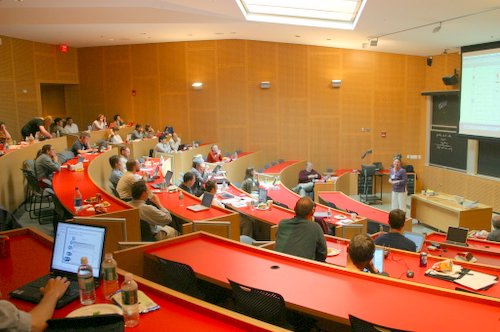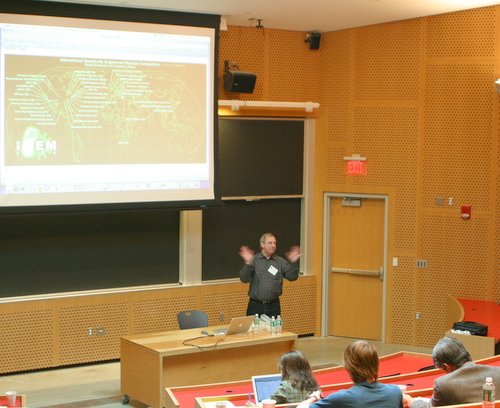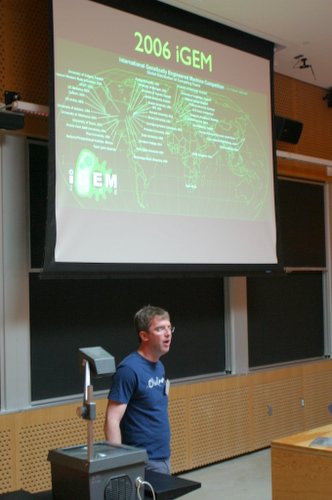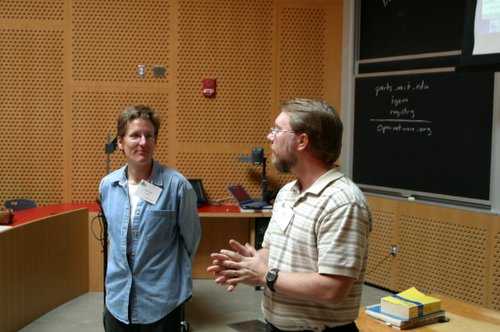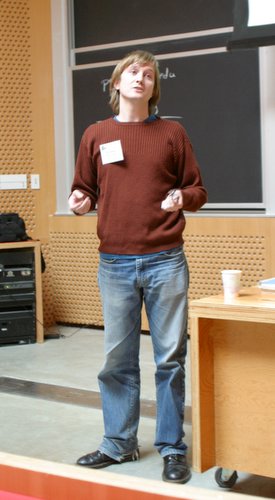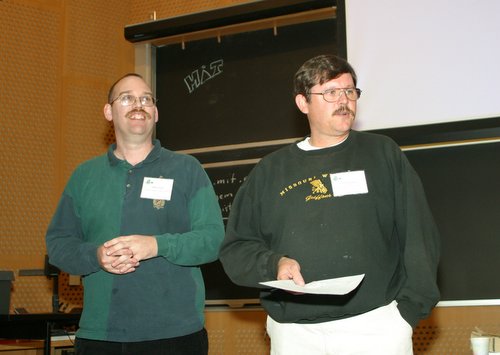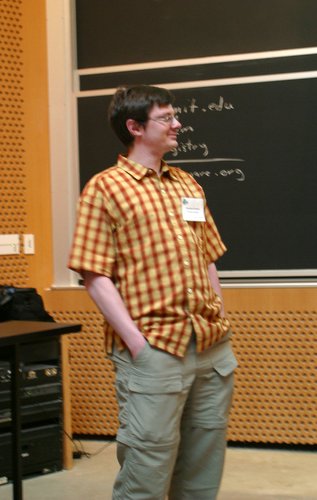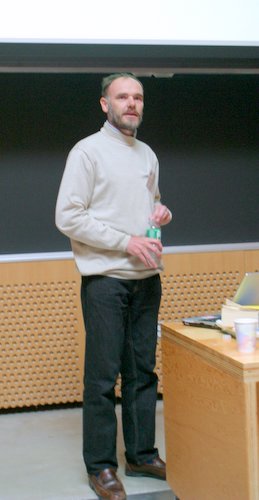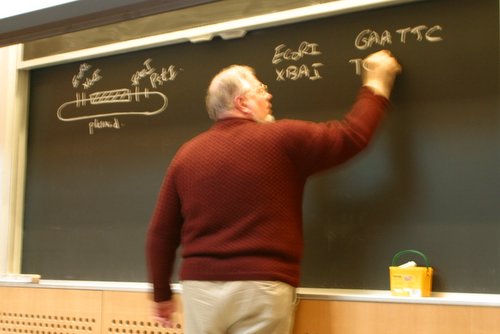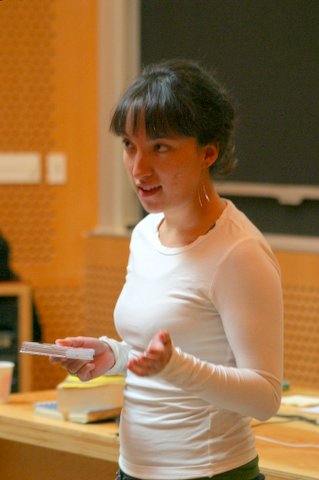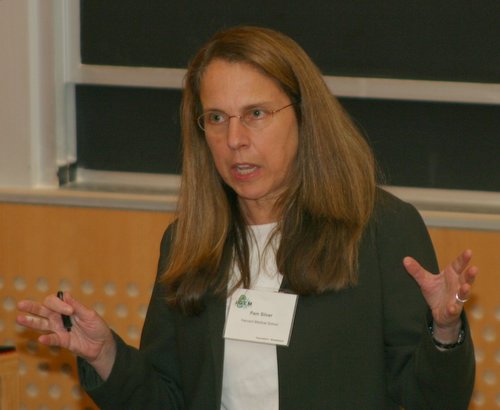MIT teach the teachers summary 2006
From 2006.igem.org
MIT Teacher's Workshop, May 6th, 2006
Presentations and other information are summarized here. Add your notes and comments!
Attendance: approx. 50 instructors
Introduction - Randy Rettberg
Welcome comments, introduction to iGEM, comments on growth of program
Foundations of Synthetic Biology - Drew Endy
[http://mit.edu/endy/www/scraps/talks/iGEM/Endy.iGEM.TW.pdf slideshow]
Notes
DNA as technology Examples: Folding DNA Biological materiels science Growing houses Reprogramming bacteria: 100 person years to do the work GreenFuel: algal scrubbing of powerplant emissions Controlled invastion of cancer cells (voight) Resurrection of 1918 influenza Composite genomes and other full genome engineering Re-engineered E. coli Elowitz, ring oscillator
All of this is in the front line biology literature. This is still experimental - unlike other engineering disciplines. Hard work, long time. An electrical engineer can make a ring oscillator in 5 minutes. How can we make biology faster and easier?
Struggle, limited success, struggle. How can we get beyond the research project? This is where the abstraction hierarchy is important. Parts > Devices > Systems The Texas group created BioFilm with one new part and several pre-existing ones.
Classical Biotechnolgy founded on:
- Recombinant DNA
- Polymerase Chain Reaction
- Sequencing
Synthetic biology brings 3 more technologies
- Synthesis of DNA
- Standardization
- Abstraction
These technologies will be at least as important.
DNA synthesizers take information and translate into physical DNA (genetic information to genetic material). DNA synthesis still has a long way to go, but it's getting better quickly. Carlson curve shows this growth.
The complexity of creating DNA, once a long process, becomes: Get me this DNA. This creates a new problem: figuring out what we want.
Standards: important because it will determine how we interoperate. They are not boring. They make things easier to do. This is exciting! Example of standardization (1864) - argument for the standardization of screw threads.
There are all sorts of standards challenges in biology. Lots of work!
Physical composition. We need standards for the assembly of DNA, because we don't want to worry about assembly. We want the end product! The registry of standard parts was created so that students could share parts. The synthesis budget wasn't sufficient to cover all de novo synthesis.
Example of Datasheet (Bba_F2620). High water mark of current part standardization. Good, but we need better standards. NEB catalog also has good parts listing. The registry is an open source catalog.
Functional composition is also something that needs standards. Something as simple as promoter>rbs>coding does not work reliably. We need to see the failures! The failures are important, to understand why the failure occurred. This might allow the incorporation of, for example, a header sequence that might allow for more reliability.
Abstraction: we would like to make a technology that makes biology to interact with. Function in biology is organized across levels, to prevent being overwhelmed by information.
DNA > genetic material > taatacgactcactatagggacga (consensus promoter sequence for T7 RNA polymerase. Hard to remember and understand. Analogy is trying to program a computer by pushing 0's and 1's around with a toothpick.
Next level: Make it a part object - eg. R0083. Describe additional functional details. This is blackboxing.
Next level: Assemble parts to make higher level parts, or Devices (one or more parts with a human-defined function, eg. an inverter)
Next level is Systems - one or more devices that provide a human-defined function.
By coupling the systems using the rate of gene expression, a common signal carrier is used to link the devices together.
Barriers can be used to isolate information in the various layers. There is no need for a systems designer to know anything about the parts that make up devices, or the DNA code that underlies the parts.
Teaching Challenges:
The idea of standard parts in biology is very new. Even most scientists aren't sure about this yet. We're still in the "stone age". The materials used in construction are derived from nature, but heavily processed to produce more powerful substrates.
What is the most important attribute of a standard biological part? Lots of ideas - functionality, composibility, etc. Drew argues: that all the information is available so that the designer of the part need not be consulted.
Made a comic strip! Nice propaganda, but ultimately a failure. It hasn't worked so well for students.
In the end, the three technologies aiding synthetics are working to make it easier to engineer biological systems.
References
Questions:
How to integrate bioethics into this material? Drew has found an integrated approach seems to work best. A standalone module did not work as well. Many students are unfamiliar with the history of recombinant DNA technology. The opinions surrounding synthetics can vary widely. There are issues about ownership and sharing of information. How should the community be organized? There is no American Society of Genetic Engineers.
Google "Synthetic Society"
VIDEO of Synthetic Society: Will be added very soon.
Action item: add a section on biological ethics to assist instructors introduce the topic to their teams
iGEM 2006 Organization - Randy Rettberg
Which hat are we going to wear on a daily basis? Are we seeking new discoveries, or working to make systems reliable. The latter is the focus of iGEM. Engineers struggle, but there is success, and then there is more success, and then companies, sports cars, etc...
We are testing the idea:
Can simple biological systems be built from standardized parts and be used in living cells. The answer is yes. We have examples.
Soon: Devices engineers. Systems architects.
The goal is not just to do science and something cool. It is to make an industry. The biological revolution is still at a very early stage, despite the "success" of biotech. Perhaps around 1850, at the very start of the industrial revolution. The ohm had been invented, but the paper hadn't been translated yet. Biology doesn't have ohms and other measurements yet. We need catalogs. We need suppliers.
The way to do hard things is to teach students to do them!
Review of early iGEM programs, IAP, and the [http://parts2.mit.edu/projects/iap2004/polkadorks/index.html E. colibrator] or Polkadorks
Comments on biological risk spectrum: Our goal is to make sure that we have lots of happy, well-informed, constructive students.
iGEM timeline: Still early for many of the schools involved, especially Europe.
Jamboree Format:
(40 @ 20 minutes) / 3 conference rooms = 4.2 hours total We have reserved ground floor of Stata Center More Posters More breaks Projects will be on iGEM wiki Parts in the registry (and the DNA too!): Parts that are not well documented or that have not been placed in the registry weaken the program year over year.
Two team formats:
- Formal structured team, with rules
- Unstructured teams
Judging: There will be academic and industry judges. Three teams. And tangible prizes.
Prize Categories:
Introduction to Schools - (Various speakers)
Each school represented provided a short summary about their iGEM team - how it came together, composition, whether they are funded, and more. Some random photos follow...
Arizona
Brown
Missouri
Princeton
Slovenia
Introduction to Ambassador Program - Andrew Hessel
The ambassador program is new for 2006 to help schools be successful. See the Ambassador section of the wiki for more information.]]
Introduction to iGEM Resources - Randy Rettberg
OpenWetWare
[http://openwetware.org OpenWetWare] is a continually online community of synthetic biology labs that is a valuable resource for iGEM teams. The protocols section in particular should be helpful to iGEM teams, especially for students unfamiliar with molecular biology work. OWW is adding many new features that add to MediaWiki, including the ability to display chemical structures and graphs.
Notes on the iGEM wiki
All iGEM participants will have accounts on the iGEM wiki. If something needs to be added, one solution is just to add it! The content is aggregative and constantly evolving. Everyone is encouraged to explore and contribute.
Demonstration of the New Registry
Overview
The Registry of Standard Biological Parts has been completely updated. (The development version of Registry will be released for use in a few days.) The new Registry is seamlessly intertwined with a Wiki, to allow the display of registry data while providing the flexibility for clients to expand on the listing, update part information, etc.
Walk through example of Registry Account Creation
Process of how to create a new Registry Account and configure it
The BioBrick Standard - Tom Knight
Every experiment turned into two: the one that he wanted to do, and the experiment to assemble the DNA. In 1999, started thinking about doing Standard Assemblies. The model was the Lego brick, where parts could be assembled in a very general way.
All the basic parts have a very stylized structure.
- Parts are flanked by EcoRI/XbaI or SpeI/PstI sites
- All parts must these sequences: EcoRI (G|AATTC), XbaI (T|CTAGA), SpeI (A|CTAGT), PstI (CTGCA|G), and also NotI (GC|GGCCGC)
- To assemble, part 1 is cut with E/S, while part 2 is cut with X/P
- Complimentary overhangs are created, but the joining (ligation) creates a new mixed site that is different than the original recognition sites.
- The result is that any BioBrick can be assembled with any other.
There is another way of doing this that makes final selection easier: triple ligations
- Part 1 is released with E/S
- Part 2 is released with X/P
- These parts are mixed with a linearized construction plasmid with free E/P overhangs and containing one of three antibiotic marker. After ligation, this allows a different antibiotic from Part 1 and Part 2 (or other construction plasmids) to be utilized, reducing unwanted background.
The construction plasmids are included in the DNA library that Meagan will be sending out to each school.
- Registry Plasmid nomenclature
pSB1A3 - (plasmid Synthetic Biology 1 - based on pUC19)(Ampicillin resistance)(3= describes multiple cloning site+transcriptional terminators)
Also available:
- pSB1AK3 (kanamycin)
- pSB1AT3 (tetracycline)
- pSB1AC3 (chloramphenicol)
- pSBZK3 (2=inducible copy #)
- pSB3K3 (based on p15)
- pSB4K3 (based on pSC101)
See the Registry for more information on all the plasmids! These notes are rough and may contain errors!
Creating a BioBrick Part - Randy Rettberg
Example of how to create and edit a BioBrick part...
Note: Step by step information about how to create BioBrick parts will be written after the development version of the Registry is released.
Also, contact your ambassador (or any other one) if you have questions. If we can't answer your question, we'll hit Randy for an answer. And you can bet that Q and A will be posted on the wiki shortly thereafter.
Sending Parts to the Registry - Meagan Lizarazo
If you don't send your parts to the Registry, how are other people going to use them?
See the full instructions [http://partsregistry.org/Help:How_to_send_parts here].
Yeast Too! - Pam Silver
Overview of yeast life cycle and genetics.
